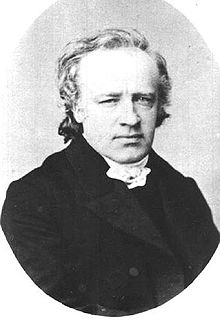Heinrich Louis d'Arrest
Heinrich Louis d'Arrest (born August 13, 1822 in Berlin , † June 14, 1875 in Copenhagen ) was a German - Danish astronomer who worked in Germany and Copenhagen. He discovered several comets , the asteroid (76) Freia and 342 deep sky objects. He was also a co-discoverer of the planet Neptune . He is best known for his research on asteroids and comets, but also played a key role in deciphering galaxy clusters .
origin
Heinrich Louis D'Arrest's ancestors were French Huguenots who fled to Germany in 1685 after the edict of Nantes was repealed . His father was an accountant for the French colony of Louis d'Arrest .
Life
D'Arrest studied mathematics at the University of Berlin . During this time he made astronomical calculations and sky observations. On July 9, 1844, he observed a comet, the discovery of which, however, was attributed to the Frenchman Mauvais, who had seen it two days earlier. On December 28, 1844, d'Arrest discovered another comet.
In 1845 he became an assistant to Johann Franz Encke at the Berlin observatory . Together with Johann Gottfried Galle , he discovered the planet Neptune on September 23, 1846 . Galle and d'Arrest systematically searched the sky according to the information of the French Urbain Leverrier , who had calculated the position of the planet based on the orbital disturbances of Uranus .
In 1848, d'Arrest moved to the observatory of the University of Leipzig on the Pleißenburg . Here he began with a systematic determination of the position of foggy objects. In 1850 he was made an honorary doctorate from the Philosophical Faculty of the University of Leipzig, and in 1851 he completed his habilitation here. On June 28, 1851, he discovered the periodic comet 6P / d'Arrest . In the same year he published a treatise on the orbits of minor planets. In the spring of 1852 he was appointed associate professor of astronomy to prevent leaving for Washington, DC . D'Arrest initiated and promoted the construction of a new observatory in Leipzig's Johannistal .
In September 1857, d'Arrest left Leipzig and worked as a full professor of astronomy at the University of Copenhagen . With the telescope of the Copenhagen observatory, which had an opening width of 27.5 cm, he continued his observation of foggy objects and discovered several hundred galaxies , star clusters and gas nebulae . He summarized his observations in the work Siderum Nebulosorum Observationes Havnienses , published in 1867 . On October 21, 1862, he discovered the asteroid (76) Freia .
More important for the professional world was his research into the Coma galaxy cluster , which he analyzed from 1861 to 1867 through systematic observations. The Copenhagen telescope had an ideal field of view for this purpose . About 30 years later, Max Wolf supplemented this research with photographs of the Coma heap, taken in Heidelberg and reaching deep into the room .
D'Arrest suffered badly from hypochondria in the last years of his life . He died of heart failure at the age of 52.
For his achievements he received numerous awards and honors (1875 gold medal of the Royal Astronomical Society ). He was a member of the Academy of Sciences of Denmark , Sweden , Saint Petersburg , Leipzig and Munich , the British Royal Astronomical Society and Knight of the Danish Order of Dannebrog .
The lunar crater D'Arrest , the crater D'Arrest on the Martian moon Phobos and the asteroid (9133) d'Arrest were named in his memory .
family
On November 4, 1851, he married the daughter of the astronomer and mathematician August Ferdinand Möbius , Auguste Emilie Möbius (born October 19, 1822 in Leipzig; † December 28, 1897 in Copenhagen), with whom he had a daughter (Doris Sophie, * March 5, 1853) and had a son (Louis, born March 31, 1855).
literature
- Ernst Zinner: d'Arrest, Heinrich Louis. In: New German Biography (NDB). Volume 1, Duncker & Humblot, Berlin 1953, ISBN 3-428-00182-6 , p. 398 ( digitized version ).
- Second supplement to the quarterly journal of the Astronomical Society, Volume IV, page 1 , obituary
Web links
- Heinrich Louis d'Arrest in the professorial catalog of the University of Leipzig
- Overview of Heinrich Louis d'Arrest's courses at the University of Leipzig (winter semester 1851 to summer semester 1857)
- HL d'Arrest publications in the Astrophysics Data System
- JC Adams: Address, Delivered by the President, Professor Adams, on presenting the Gold Medal of the Society to Professor Heinrich D'Arrest. Monthly Notices of the Royal Astronomical Society, Vol. 35 (1875), pp. 265–276 (laudation on the occasion of the award of the gold medal, English)
- NN: D'Arrest. Astronomical register, Vol. 13 (1875), pp. 207-208. (Obituary, English)
- NN: Heinrich Louis D'Arrest Monthly Notices of the Royal Astronomical Society, Vol. 36 (1876), p. 155. (Obituary, English)
- Martin Schneider: Heinrich Louis d'Arrest (1822-1875) . In: Institute for Saxon History and Folklore (Ed.): Saxon Biography .
| personal data | |
|---|---|
| SURNAME | Arrest, Heinrich Louis d ' |
| BRIEF DESCRIPTION | German-Danish astronomer |
| BIRTH DATE | August 13, 1822 |
| PLACE OF BIRTH | Berlin , Kingdom of Prussia |
| DATE OF DEATH | June 14, 1875 |
| PLACE OF DEATH | Copenhagen , Denmark |
